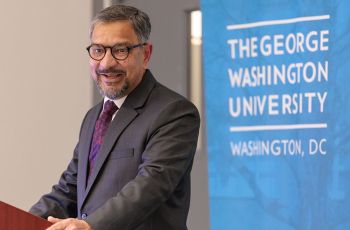Innumerable questions and concerns loom after a cancer diagnosis. Among them: Should I participate in a clinical trial, or should I stick with the standard of care?
Cancer treatment success rates continue to rise. The National Cancer Institute predicts that by 2024, almost 19 million people will live well beyond their diagnosis. Clinical trials play an important role in such progress.
“[They] are the mechanism by which we make progress in the treatment of cancer," says Robert Siegel, MD, associate center director for education, training, and network development at the George Washington University (GW) Cancer Center and professor of medicine at the GW School of Medicine and Health Sciences (SMHS).
Treatments and techniques from clinical trials may be more effective than the current standard of care, or they may be equally effective but have fewer side effects, he explains.
Finding the right fit
Not every patient who signs up to be a part of a clinical trial will be accepted. Trials have certain criteria that a patient must meet to be included, measures that vary from trial to trial.
A patient signing up to take part in a trial must first undergo a screening procedure, which can include blood tests, physical examinations, a CAT scan, an electrocardiogram (EKG) test, and other tests and procedures required for the study.
If patients have, say, an abnormal EKG, or if their medical record shows a history of cardiovascular disease, they may be excluded from a trial. In addition, a person who is confined to a bed may not be considered for participation.
Patients should be guided by their physician when considering participating in a trial, Siegel says. Physicians can identify the right clinical trials for their patients and determine whether they’re good candidates for participation.
Before a patient is accepted for clinical trial, he or she must review and sign an informed consent form. The form includes nitty-gritty details on the trial, such as participation requirements, possible side effects of the treatment, and possible benefits.
Once the form is signed and the patient meets all the eligibility criteria, therapy begins.
Participation expectations
Clinical trial volunteers will have to meet certain obligations during the course of the trial. Some of the obligations may depend on what stage of development the drug is in.
“There will be questions that need to be answered about how the drug behaves in the patient, what sort of side effects it has, and how quickly those [side effects] occur and disappear," explains Richard Lush, PhD, director of the Clinical Trials Office at the GW Cancer Center. “When those questions need to be answered earlier in the development, the patient might be asked to come back into the clinic for additional visits so that the patient can be checked and have laboratory tests done to make sure [he or she is] OK."
In later development stages, visits may ease up because doctors have a better understanding of what to expect from the drug.
However, generally there is a limit to the number of visits a patient needs to make. “We realize that people have lives they want to live even while on a study," Lush says.
He adds that patients are encouraged to talk with the doctor and study team at any time if they have questions, or if they are experiencing a new symptom or side effect.
Betting on benefits, but considering the risks
The benefits of a clinical trial can differ, as can any associated risks.
The major benefit from a Phase I trial can be, simply, a new option when other treatments have been exhausted. Drugs administered during such trials could prolong a participant’s life or better their quality of life, says Imad Tabbara, MD, director of the GW Medical Faculty Associates Blood & Bone Marrow Transplant Program and professor of medicine at SMHS. For Phase III trials, benefits could include a drug with improved efficacy, treatment that is less toxic than the alternatives, a medication that’s easier to administer, or a medication that causes milder or fewer side effects.
However, no trial is risk-free.
“We have to be frank and tell [patients] we don’t know everything about this medication, that’s why we’re doing this [closely regulated] clinical trial," Tabbara explains. “Sometimes unexpected things happen."
He adds that if a patient experiences unexpected outcomes, the trial will be halted for further investigation into the problem. If a trial is halted, patients experiencing positive outcomes from the medication may be allowed to continue to receive treatment, but that’s at the discretion of the FDA, Tabbara says.
Post-trial
A trial that gets through to Phase III often results in the treatment earning FDA approval and becoming a new option of care for patients across the United States.
The decision to participate in a trial, and whether it is the best option for an individual’s wants, needs, and health, is completely in the patient’s hands.
But one thing is true: When patients participate and treatments are found to be effective, the impact reverberates far beyond the clinic’s walls.
“For the benefit of all current and future patients with cancer, we need patients to volunteer in trials so that we can advance the drugs that will improve the lives of patients," Lush says.
The Phases
Imad Tabbara, MD, director of the GW Medical Faculty Associates Blood & Bone Marrow Transplant Program, and Richard Lush, PhD, director of the Clinical Trials Office at the GW Cancer Center, offer their expertise and advice for understanding the steps of the clinical trial process.
Phase I: The first phase of a clinical trial allows researchers to determine the efficacy of a new treatment
The patients, says Tabbara, “have received regular treatment, or standard treatment as we call it, and they didn’t respond to it, or they responded and then the cancer progressed. Those are usually the best candidates," he explains.
Phase I trials also help determine the right dose of the drug, demonstrate whether it has adverse side effects, and reveal any toxicity it might have.
Phase II: These trials are the second phase of drug development. A trial reaches Phase II once researchers have determined the effectiveness of the treatment. This second step establishes the response of individual agents when treating specific cancer types, says Lush.
These trials are often randomized, meaning trial participants receive either the new drug or a standard drug already in use. This enables researchers to compare the efficacy of the new drug to other treatments, Tabbara says.
Phase III:Largerrandomized studies are engineered during a Phase III trial, which frequently is conducted by more than one institution.
Phase III trials are conducted if the treatment demonstrated sufficient activity in early stages of development, Lush explains. These trials are the last stage of testing prior to submitting the drug for FDA approval.
Questions to Consider
From a patient perspective, before joining a clinical trial, the most important thing is to get all the facts, speak with physicians, and ask, “is this what’s best for me?"
Valuable questions to consider include:
- What are the potential side effects, and can they be managed easily?
- What kinds of results have been established with this new treatment, for instance from Phase I or Phase II trials?
- How much of a commitment will participating involve?
- Have there been any unexpected reactions in patients already participating?




